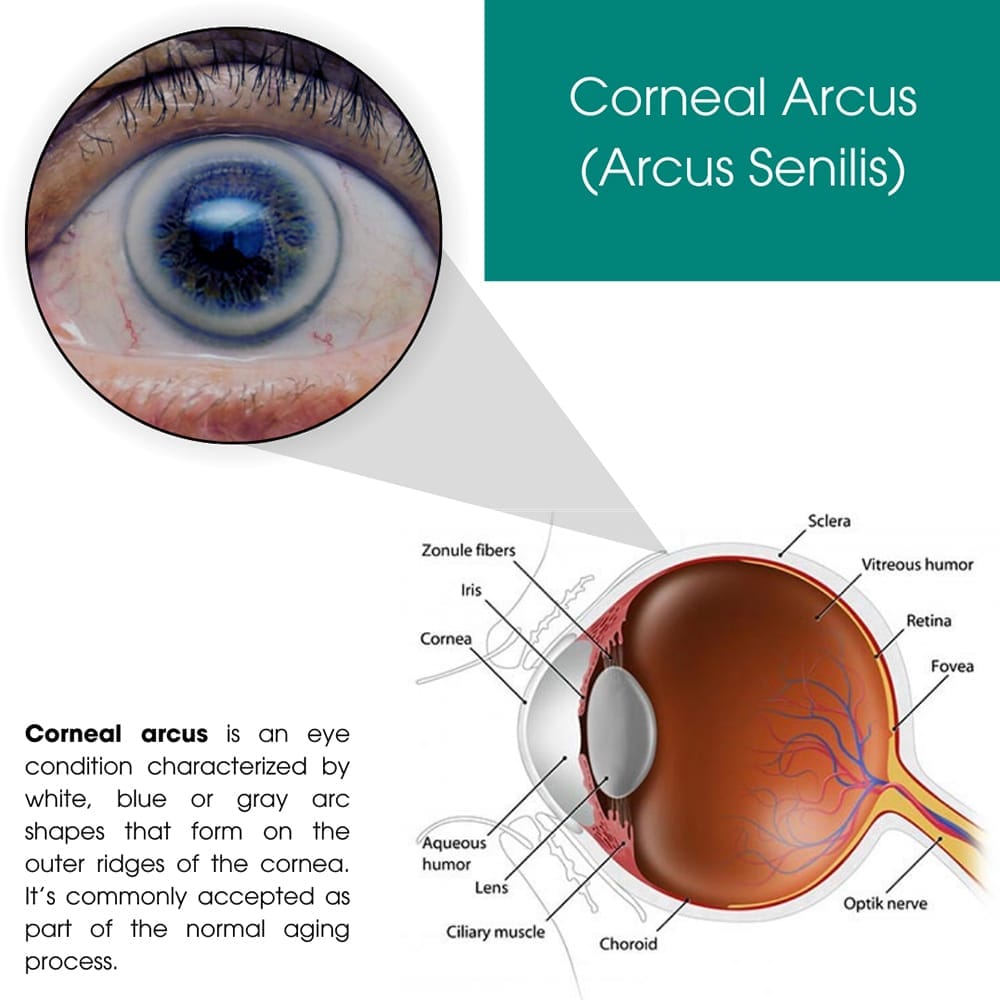Corneal arcus is an eye condition characterized by white, blue or gray arc shapes that form on the outer ridges of the cornea. It’s commonly accepted as part of the normal aging process. In fact, studies show that those who are 80 years and older have a 100 percent probability of having corneal arcus.
While the condition in and of itself isn’t dangerous, it often does point to certain underlying medical conditions that you need to be aware of. Optometrists recommend getting an eye exam as soon as possible when you notice the rings, especially if the condition appears only in one eye. Eye Physicians, located in New York City offer professional eye care to eliminate various eye ailments and the consequences they may incur. When getting treatment for everything from dry eye syndrome to itchy eyelids, you’re usually in and out in less than an hour.

The main cause for corneal arcus is the buildup of fatty deposits or lipids at the cornea, surrounding the iris. These lipids include cholesterol, phospholipids and triglycerides, all of which are linked to serious medical conditions like stroke or inflammation of the pancreas.
Triglycerides and cholesterol deposits in the eye are especially indicative of high cholesterol in the blood stream, so calcium deposits on the eyelids can let your doctor know that you may have this underlying condition.
Other risk factors that can lead to a white, dark or blue ring around the iris include:
Corneal arcus is normally divided into two medical divisions, based on the age group. If you’re 50 to 60 years and above, you’re suffering from Arcus Senilis, implying older adults. If you’re under 40 years old and have a dark ring around the iris, you have Arcus Juvenilis that implies younger adults and youth. If you see a dark ring around the iris in very young children, then immediately consult a pediatric eye doctor for emergency eye care, as it could be linked to a serious medical problem.
Corneal arcus poses no threat to the eyes, even when the white, gray or blue arcs form a complete ring around your cornea. The main reason to be concerned at the appearance of these rings is that they could be indicative of some other medical condition.
For most people, both eyes are affected. It only becomes a serious issue if you see the ring in only one eye. This usually means that the blood flow to your eyes is somehow affected due to a health problem like a blocked artery.
Other factors related to corneal arcus include:
While it may seem easy to diagnose the condition due to the ring around the cornea, there are other eye conditions with similar indications. A good example is the Limbus sign where calcium deposits in the cornea change the color of your eyes. Also, whereas corneal arcus doesn’t require treatment, Limbus sign needs immediate treatment to combat the high levels of calcium concentration in the blood.
A thorough physical examination is needed to ensure the symptoms you’re experiencing align with the corneal arcus condition. To get a closer look, a slit-lamp microscope or a biomicroscope could be used to examine the cornea and other parts of the eye in detail.
While most arcus senilis patients don’t need medical tests, there are exceptions.
Your medical doctor may suggest blood tests based on the corneal arcus diagnosis due to high risk factors for certain conditions such as:
Currently there is no treatment for corneal arcus as the condition poses little to no threat. Most studies focus on how the diagnosis of corneal arcus helps in the diagnosis of other serious medical conditions like heart disease. Additionally, for most people, the changes to the appearance of the eyes are aesthetically pleasing.
The focus of the treatment shifts from corneal arcus to the underlying conditions. A heart-to-heart discussion about trans-fat, saturated fat and cholesterol may help you understand how your diet affects your health, and what kind of diet may be used to lower your cholesterol levels.
One thing to note, however, is that corneal arcus is permanent. Once you get it, the ring stays even after you have lowered your cholesterol levels. To ensure that you get the proper diagnosis, appropriate referrals and superior eye care, contact Eye Physicians office in Manhattan. You can expect to get in and out with a definitive eye care plan in less than an hour.
Eye Physicians
110 Lafayette St, Suite 503
New York, NY 10013
(212) 292-4814
Entrust the care of your precious eyesight to highly skilled and experienced eye care professionals. For top-notch ophthalmologists and optometrists in Downtown Manhattan, choose Eye Physicians. Eye Physicians ensures prompt care, precise diagnosis, and personalized treatment plans.
Schedule an Appointment